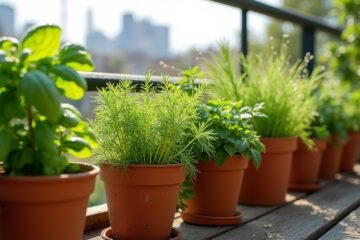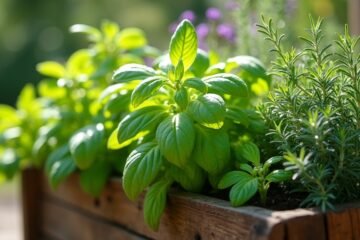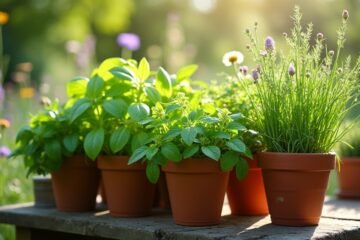Want to create a little herb paradise in your small space? Start by planting zesty chives in spring or vibrant basil as the frost fades! Summer’s the time for spicy cilantro, while mint can thrive indoors in winter. Get creative with colorful pots or stacked containers, making your garden an aromatic masterpiece! Remember, checking soil moisture is key—just stick your finger in there! Curious about preserving all that herb goodness? There’s more to discover!
Choosing the Right Herbs for Your Space
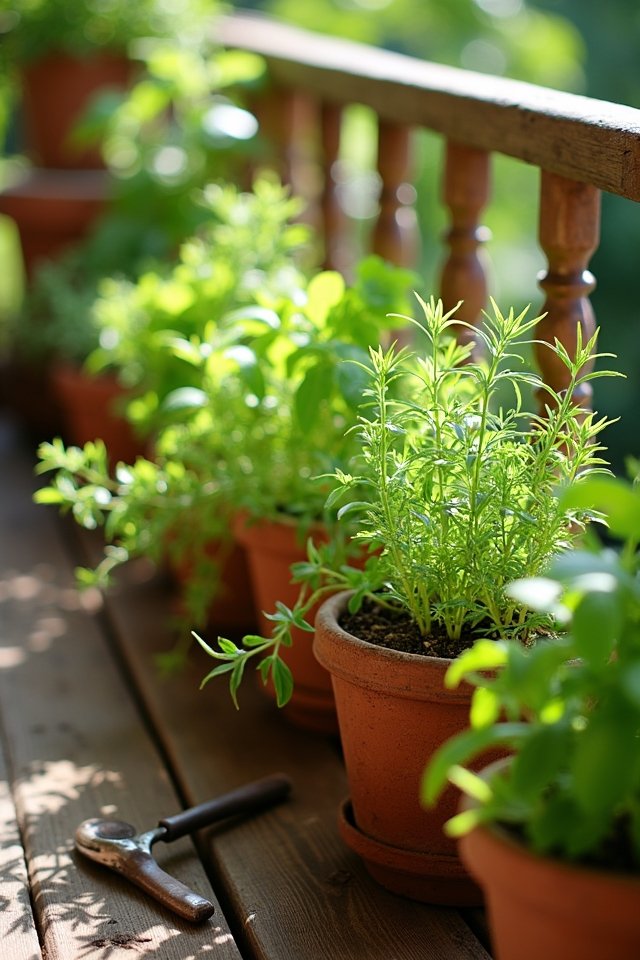
When you’re thinking about planting herbs in small spaces, it’s like picking the perfect puzzle pieces for your garden! You want flavors that pop and aromas that dance! Basil, with its sweet fragrance, thrives in a sunny corner. Mint’s vibrant green leaves are not just a treat for your dishes—they’re a thrill for your senses! If you love to cook, consider chives; they’re easy to grow and add a lovely oniony kick to your meals. You can’t forget about thyme, either—its delightful earthy scent beckons culinary inspiration. Just imagine snipping fresh herbs right from your kitchen windowsill! Finding the right herbs makes every dish a masterpiece, so dig in and watch your mini garden flourish!
Best Times to Plant Herbs by Season
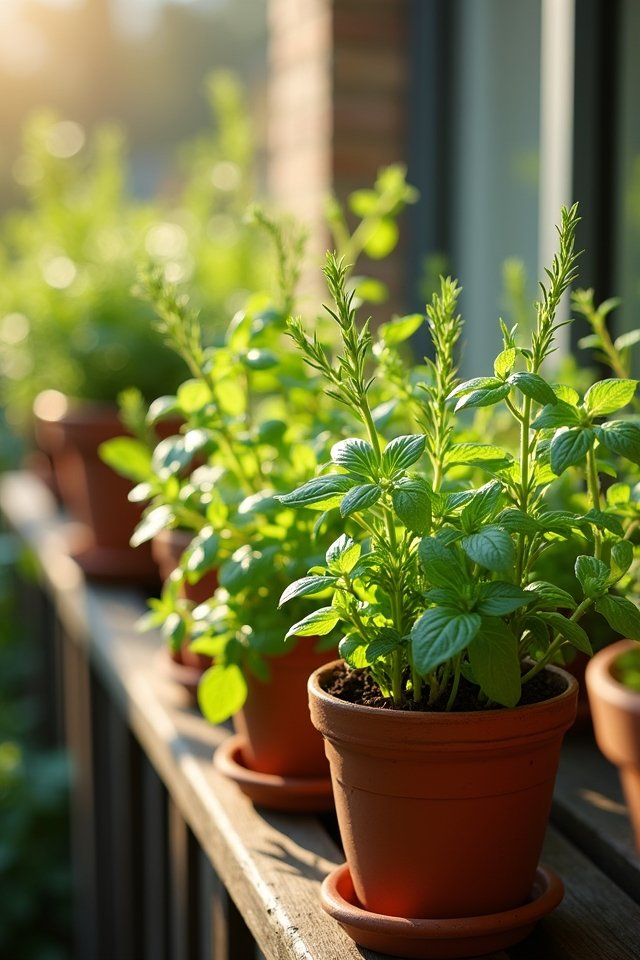
Planting herbs can feel like a seasonal dance, and knowing the best times to plant them can make all the difference! Spring’s the time for vibrant basil and fragrant dill, bursting with potential. As the frost fades, you’ll want to get your seedlings or seeds in the warm soil. Summer loves the spicy zing of cilantro and zesty chives, perfect for those sunny days ahead. Don’t forget about fall! That’s when you can enjoy the robust flavors of rosemary and sage, savoring their earthy scents as the air cools down. Winter’s colder, but you can still grow delightful herbs indoors—think cozy windowsill pots of mint and thyme, adding greenery to your home! Why wait? Let’s get planting!
Preparing Your Small Garden for Planting
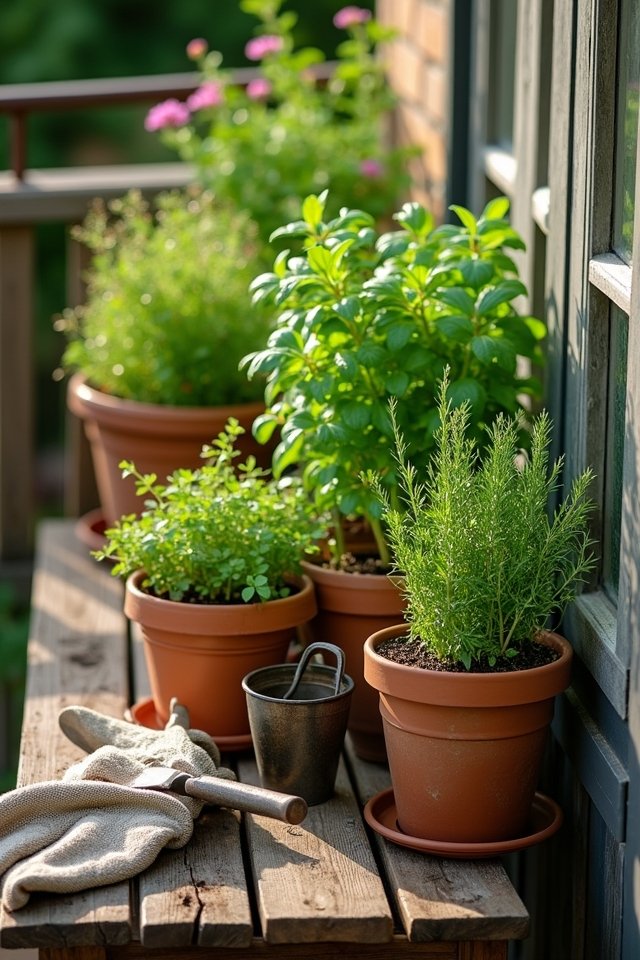
Your small garden is like a blank canvas, just waiting for the splashes of color and fragrance that herbs can bring! Let’s get it ready for your herb masterpieces! Start by clearing out any weeds and debris—it’s like pulling the pesky bits from your favorite painting. Next, check your soil! It should be rich and well-drained, inviting those roots to thrive. If it feels packed or tired, mix in some compost for a nutrient boost—like giving your garden a hearty smoothie! Make sure you consider sunlight too; herbs love basking in the warm rays. After prepping, don’t forget to plan your space wisely—tight, creative arrangements can transform your garden into a vibrant herb haven! Ready to grow?
Container Gardening: Maximizing Limited Space

Even if you’ve got just a tiny balcony or a cozy windowsill, you can still enjoy the joy of gardening with container gardening! Picture vibrant pots bursting with fresh basil, mint, or chives, adding zest to your meals. Choose colorful containers that match your style—ceramic, recycled, or even hanging planters—they’re like art pieces! Stack them for vertical gardens, maximizing every inch of space. Don’t shy away from mixing herbs; a pizza pot with oregano and parsley has never sounded better! And guys, don’t forget to play with textures; a smooth pot paired with a rough wooden crate creates charm! So, roll up those sleeves, plunge into container gardening, and transform your small space into a flavorful oasis! Who knew limited spaces could spark so much creativity?
Soil Considerations for Herb Growth
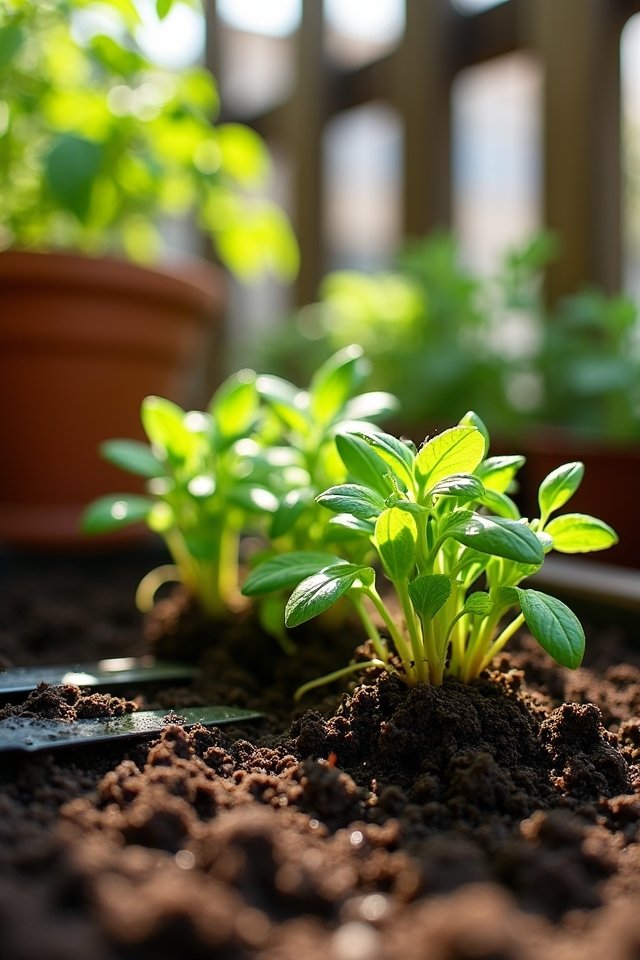
When it comes to growing herbs, the quality of your soil can make all the difference—think of it as their cozy bed! You want a well-draining mix, rich in nutrients, and, if possible, a splash of compost for that extra oomph! Picture your herbs nestled in a fluffy, fertile cloud, soaking up everything they need to thrive.
A pH level around 6.0 to 7.0 is ideal. Not sure how to check? It’s easier than it sounds—grab a simple kit! Try mixing in perlite or vermiculite for aeration, ensuring those roots can breathe. Remember, your herbs are practically royalty; treat them well, and they’ll reward you with vibrant flavors and delightful aromas! Isn’t that worth it?
Sunlight Requirements for Various Herbs
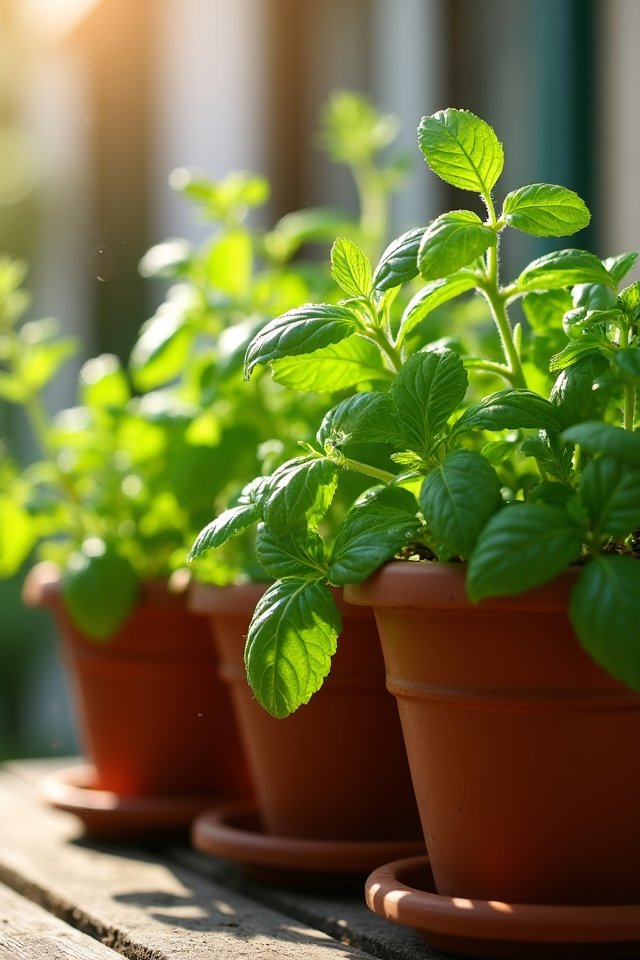
Herbs are sun-worshippers, and their happiness hinges on the right amount of sunlight! Imagine your basil, thriving under full sun, basking like it’s on a Mediterranean vacation! Give it 6 to 8 hours, and watch it flourish! On the other hand, cilantro enjoys a softer touch, preferring partial shade—think of it as the introvert of herbs.
Mint? It’s like a sunbather that can handle less light—perfect for those cozy, dim spots in your garden! Oregano loves the spotlight too, needing a strong 6 hours, while parsley is the adaptable type, thriving in both full sun and partial shade. So, position your herbs wisely, and they’ll repay you with flavor-packed leaves that make your dishes sing!
Companion Planting Strategies for Herbs
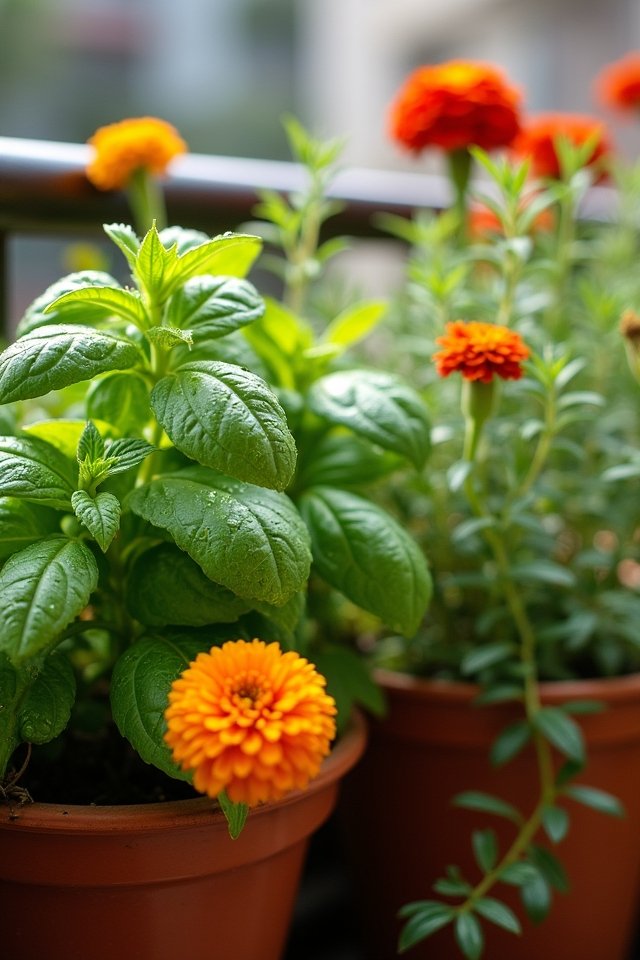
To boost your herb garden’s success, consider pairing plants that play nice together! Companion planting can enhance flavors, deter pests, and even stimulate growth. Here are four stellar combinations to get you started:
- Basil and Tomatoes: This duo isn’t just classic—it’s a match made in culinary heaven!
- Rosemary and Sage: These two robust herbs not only share space well, but their flavors complement each other beautifully.
- Chives and Carrots: Chives help ward off pesky carrot flies, and those vibrant green tops just look gorgeous together!
- Mint and Peas: Mint cools down sweet peas while adding a revitalizing splash of aroma.
Experimenting with these pairings can transform your small herb garden into a powerhouse of flavor and creativity! Isn’t that exciting?
Watering Needs: How Much Is Too Much?

Have you ever watched a plant wilt faster than a forgotten salad in the fridge? That’s what too much water can do! It’s tempting to keep that soil soggy, but lavender hates it, and mint just drowns. Picture your herbs taking a rejuvenating sip, just to survive, not to swim!
You need to strike a balance. Stick your finger in the soil—if it feels dry an inch down, it’s time to water. Always choose pots with drainage holes to prevent a swampy disaster! Remember, soggy roots lead to moldy misery. Instead of drowning, treat your herbs like thirsty friends—hydrate them with moderation and care! Your culinary companions will thank you with vibrant leaves and rich flavors! Isn’t that worth it?
Seasonal Maintenance for Thriving Herbs

Once the weather starts turning, a little seasonal TLC can make all the difference for your herb garden! You’re about to transform those little plants into thriving green beauties. Here’s what you can do:
- Trim and Prune: Give your herbs a haircut! Snip away any brown or wilting leaves to encourage fresh growth.
- Fertilize: Feed your plants! A balanced, organic fertilizer will give them the energy they need to flourish.
- Water Smart: Adjust your watering! With temperatures changing, check the soil moisture and water only when needed.
- Pest Patrol: Keep an eye out! Look for tiny invaders and combat them with natural remedies like soapy water.
With these steps, you’ll soon have a vibrant herb garden that’s the envy of all your neighbors! 🌿
Harvesting Techniques for Small Garden Herbs
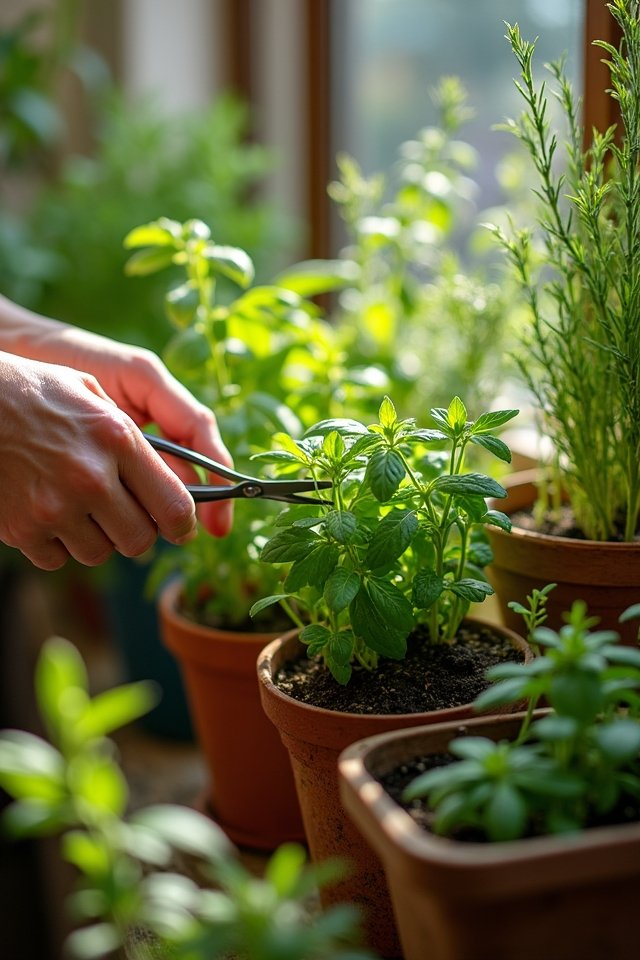
When you’re itching to spice up your meals, knowing the right harvesting techniques can make all the difference! Imagine this: gently plucking a few fresh basil leaves, the aromatic scent wafting through the air, instantly elevating your dish. Use your fingers to snip above a leaf node, encouraging growth—it’s like giving your herbs a little haircut! For herbs like parsley, simply twist the stems and yank them out—but don’t get too excited; plants appreciate a little gentleness. And remember, harvesting in the morning captures the essential oils at their peak! Isn’t that brilliant? So, grab your scissors and welcome the joy of fresh flavors in your cooking. Your taste buds will thank you for this delicious adventure!
Preserving Your Herb Bounty: Tips and Tricks
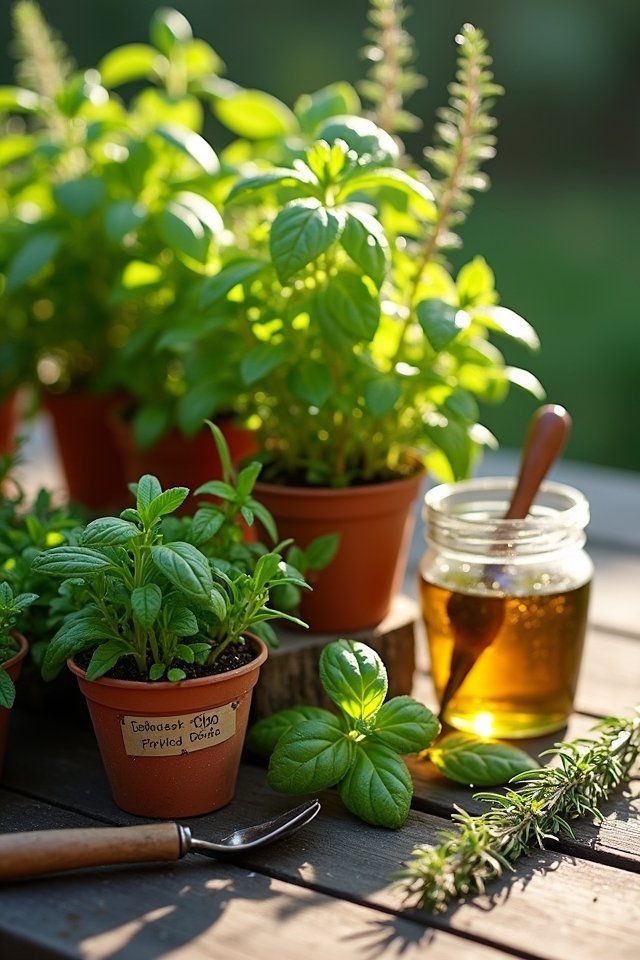
As you immerse yourself in the delightful world of herbs, it’s essential to think about how to preserve that vibrant bounty for future culinary adventures! Don’t let those precious flavors fade away. Here are some innovative ways to keep your herbs fresh and fabulous:
- Drying: Hang small bundles upside down in a dry, dark place. You’ll get a punchy, concentrated flavor!
- Freezing: Chop herbs and mix them with olive oil in ice cube trays. Instant flavor boosts at your fingertips!
- Infusing: Steep herbs in vinegar or oil for Zesty dressings that’ll wow your guests.
- Pesto Power: Whip up a herb pesto and freeze it. It’s like having a taste of summer all year long!
Frequently Asked Questions
Can I Grow Herbs Indoors During Winter?
Can you imagine fresh basil brightening up your winter meals? Absolutely! Growing herbs indoors during winter is not just possible—it’s a fantastic way to bring life into your home! Set up a sunny window spot or use grow lights, and your kitchen can bloom with flavors like thyme and rosemary. Just think of the scent wafting through the air! So, grab those pots, and let’s turn your kitchen into a cozy herb haven!
What Are the Best Herbs for Beginners?
If you’re diving into the world of herbs, you can’t go wrong with basil, mint, and parsley! These green delights sprout quickly, bringing fresh flavor to your kitchen. Imagine plucking vibrant basil leaves for a homemade pesto! Or invigorating mint leaves for your summer drinks! Start with these three, and you’ll be whisked away into a fragrant garden without ever stepping outside. Get ready to impress your taste buds and your friends!
How Do I Prevent Pests in Small Herb Gardens?
To prevent pests in your small herb garden, you’ve gotta be clever! Think of natural deterrents like garlic spray; it’s like a superhero cape for your plants! Toss in some companion plants, like marigolds, which guard your herbs like loyal sidekicks. Keep a close eye on soil health, as healthy plants ward off pests better. And don’t forget to regularly check for sneaky invaders, giving those critters the boot! Your herbs will thrive!
Can Herbs Survive in Shaded Areas?
Imagine your herbs as adventurous little explorers, ready to thrive even in dim corners! Yes, herbs can survive in shaded areas, but they’re picky about which ones—think mint or parsley. These green warriors will lean towards the light, so give ’em at least a few hours of sunlight! Just remember, too much shade turns them into sad little plants. So, what’s stopping you from creating a shadowy herb haven? Jump in and get planting!
What Containers Work Best for Herbs?
When it comes to containers for your herbs, think outside the box—literally! Terracotta pots are great for drainage, while stylish ceramic can jazz up your space. Don’t overlook hanging planters; they’re like little green chandeliers! Also, consider repurposing large jars—your herbs will look fabulous peeking out. Just remember to guarantee your containers have drainage holes, or your plants might feel like they’re drowning. Happy planting! Isn’t that exciting?
